Lunar Calendar Usage to Improve Forecasting Accuracy Rainfall via Machine Learning Methods
Abstract
:1. Introduction
2. Materials and Methods
2.1. Long Short-Term Memory (LSTM)
- Forget gate.
- 2.
- Input gate.
- 3.
- Cell state.
- 4.
- Output gate.
- 5.
- Hidden state.
2.2. Gated Recurrent Unit (GRU)
2.3. Stacked LSTM and GRU
2.4. (Stacked) Bidirectional LSTM and (Stacked) Bidirectional GRU
2.5. Preprocessing Data
3. Results
3.1. Calendar Conversion Results
3.2. Forecasting Result Comparison
4. Conclusions
Author Contributions
Funding
Institutional Review Board Statement
Informed Consent Statement
Data Availability Statement
Acknowledgments
Conflicts of Interest
References
- Bartlein, P.J.; Shafer, S.L. Paleo Calendar-Effect Adjustments in Time-Slice and Transient Climate-Model Simulations (PaleoCalAdjust v1.0): Impact and Strategies for Data Analysis. Geosci. Model Dev. 2019, 12, 3889–3913. [Google Scholar] [CrossRef]
- Irfan, I. Comparative Study of Fazilet Calendar and Mabims Criteria on Determining Hijri Calendar. Al-Hilal J. Islam. Astron. 2023, 5, 99–116. [Google Scholar] [CrossRef]
- Hendikawati, P.; Subanar; Abdurakhman; Tarno. Optimal Adaptive Neuro-Fuzzy Inference System Architecture for Time Series Forecasting with Calendar Effect. Sains Malays. 2022, 51, 895–909. [Google Scholar] [CrossRef]
- Tang, T.; Jiao, D.; Chen, T.; Gui, G. Medium- and Long-Term Precipitation Forecasting Method Based on Data Augmentation and Machine Learning Algorithms. IEEE J. Sel. Top. Appl. Earth Obs. Remote Sens. 2022, 15, 1000–1011. [Google Scholar] [CrossRef]
- Archontoulis, S.V.; Castellano, M.J.; Licht, M.A.; Nichols, V.; Baum, M.; Huber, I.; Martinez-Feria, R.; Puntel, L.; Ordóñez, R.A.; Iqbal, J.; et al. Predicting Crop Yields and Soil-plant Nitrogen Dynamics in the US Corn Belt. Crop Sci. 2020, 60, 721–738. [Google Scholar] [CrossRef]
- Ceglar, A.; Toreti, A. Seasonal Climate Forecast Can Inform the European Agricultural Sector Well in Advance of Harvesting. npj Clim. Atmos. Sci. 2021, 4, 42. [Google Scholar] [CrossRef]
- Lala, J.; Tilahun, S.; Block, P. Predicting Rainy Season Onset in the Ethiopian Highlands for Agricultural Planning. J. Hydrometeorol. 2020, 21, 1675–1688. [Google Scholar] [CrossRef]
- Sodnik, J.; Mikoš, M.; Bezak, N. Torrential Hazards’ Mitigation Measures in a Typical Alpine Catchment in Slovenia. Appl. Sci. 2023, 13, 11136. [Google Scholar] [CrossRef]
- Adu-Gyamfi, A.; Poku-Boansi, M.; Darpoh, L.; Asibey, M.O.; Owusu-Ansah, J.K. Rainfall Challenges and Strategies to Improve Housing Construction in Sub-Saharan Africa: The Case of Ghana. Hous. Stud. 2023, 38, 1155–1190. [Google Scholar] [CrossRef]
- Zhang, J.; Zhong, D.; Wu, B.; Lv, F.; Cui, B. Earth Dam Construction Simulation Considering Stochastic Rainfall Impact. Comput. Civ. Infrastruct. Eng. 2018, 33, 459–480. [Google Scholar] [CrossRef]
- Golz, S.; Naumann, T.; Neubert, M.; Günther, B. Heavy Rainfall: An Underestimated Environmental Risk for Buildings? E3S Web Conf. 2016, 7, 08001. [Google Scholar] [CrossRef]
- Waqas, M.; Humphries, U.W.; Wangwongchai, A.; Dechpichai, P.; Ahmad, S. Potential of Artificial Intelligence-Based Techniques for Rainfall Forecasting in Thailand: A Comprehensive Review. Water 2023, 15, 2979. [Google Scholar] [CrossRef]
- Hammad, M.; Shoaib, M.; Salahudin, H.; Baig, M.A.I.; Khan, M.M.; Ullah, M.K. Rainfall Forecasting in Upper Indus Basin Using Various Artificial Intelligence Techniques. Stoch. Environ. Res. Risk Assess. 2021, 35, 2213–2235. [Google Scholar] [CrossRef]
- McGovern, A.; Elmore, K.L.; Gagne, D.J.; Haupt, S.E.; Karstens, C.D.; Lagerquist, R.; Smith, T.; Williams, J.K. Using Artificial Intelligence to Improve Real-Time Decision-Making for High-Impact Weather. Bull. Am. Meteorol. Soc. 2017, 98, 2073–2090. [Google Scholar] [CrossRef]
- Chambers, L.E.; Plotz, R.D.; Lui, S.; Aiono, F.; Tofaeono, T.; Hiriasia, D.; Tahani, L.; Fa'anunu, O.; Finaulahi, S.; Willy, A. Seasonal Calendars Enhance Climate Communication in the Pacific. Weather. Clim. Soc. 2020, 13, 159–172. [Google Scholar] [CrossRef]
- Ferrouhi, E.M.; Kharbouch, O.; Aguenaou, S.; Naeem, M. Calendar Anomalies in African Stock Markets. Cogent Econ. Financ. 2021, 9, 1978639. [Google Scholar] [CrossRef]
- Lessan, N.; Ali, T. Energy Metabolism and Intermittent Fasting: The Ramadan Perspective. Nutrients 2019, 11, 1192. [Google Scholar] [CrossRef]
- Oynotkinova, N.R. Calendar Rites and Holidays of the Altaians and Teleuts: Classification and General Characteristics. Sib. Filol. Zhurnal 2022, 332, 153–165. [Google Scholar] [CrossRef]
- Bell, W.R.; Hillmer, S.C. Modeling Time Series with Calendar Variation. J. Am. Stat. Assoc. 1983, 78, 526–534. [Google Scholar] [CrossRef]
- Ghamariadyan, M.; Imteaz, M.A. Monthly Rainfall Forecasting Using Temperature and Climate Indices through a Hybrid Method in Queensland, Australia. J. Hydrometeorol. 2021, 22, 1259–1273. [Google Scholar] [CrossRef]
- Kumar, D.; Singh, A.; Samui, P.; Jha, R.K. Forecasting Monthly Precipitation Using Sequential Modelling. Hydrol. Sci. J. 2019, 64, 690–700. [Google Scholar] [CrossRef]
- Heddam, S.; Ptak, M.; Zhu, S. Modelling of Daily Lake Surface Water Temperature from Air Temperature: Extremely Randomized Trees (ERT) versus Air2Water, MARS, M5Tree, RF and MLPNN; Elsevier: Amsterdam, The Netherland, 2020; Volume 588, ISBN 0000000280. [Google Scholar]
- Xie, J.; Hong, T. Load Forecasting Using 24 Solar Terms. J. Mod. Power Syst. Clean Energy 2018, 6, 208–214. [Google Scholar] [CrossRef]
- Li, G.; Yang, N. A Hybrid SARIMA-LSTM Model for Air Temperature Forecasting. Adv. Theory Simul. 2023, 6, 220502. [Google Scholar] [CrossRef]
- Sirisha, U.M.; Belavagi, M.C.; Attigeri, G. Profit Prediction Using ARIMA, SARIMA and LSTM Models in Time Series Forecasting: A Comparison. IEEE Access 2022, 10, 124715–124727. [Google Scholar] [CrossRef]
- Smyl, S. A Hybrid Method of Exponential Smoothing and Recurrent Neural Networks for Time Series Forecasting. Int. J. Forecast. 2020, 36, 75–85. [Google Scholar] [CrossRef]
- Darmawan, G.; Handoko, B.; Faidah, D.Y.; Islamiaty, D. Improving the Forecasting Accuracy Based on the Lunar Calendar in Modeling Rainfall Levels Using the Bi-LSTM Method through the Grid Search Approach. Sci. World J. 2023, 2023, 1863346. [Google Scholar] [CrossRef]
- Qiu, G.; Gu, Y.; Chen, J. Selective Health Indicator for Bearings Ensemble Remaining Useful Life Prediction with Genetic Algorithm and Weibull Proportional Hazards Model. Meas. J. Int. Meas. Confed. 2020, 150, 107097. [Google Scholar] [CrossRef]
- Liu, S.; Ji, H.; Wang, M.C. Nonpooling Convolutional Neural Network Forecasting for Seasonal Time Series with Trends. IEEE Trans. Neural Netw. Learn. Syst. 2020, 31, 2879–2888. [Google Scholar] [CrossRef]
- Braga, A.R.; Gomes, D.G.; Freitas, B.M.; Cazier, J.A. A Cluster-Classification Method for Accurate Mining of Seasonal Honey Bee Patterns. Ecol. Inform. 2020, 59, 101107. [Google Scholar] [CrossRef]
- Karevan, Z.; Suykens, J.A.K. Transductive LSTM for Time-Series Prediction: An Application to Weather Forecasting. Neural Netw. 2020, 125, 1–9. [Google Scholar] [CrossRef]
- Roy, D.K.; Sarkar, T.K.; Kamar, S.S.A.; Goswami, T.; Muktadir, M.A.; Al-Ghobari, H.M.; Alataway, A.; Dewidar, A.Z.; El-Shafei, A.A.; Mattar, M.A. Daily Prediction and Multi-Step Forward Forecasting of Reference Evapotranspiration Using LSTM and Bi-LSTM Models. Agronomy 2022, 12, 594. [Google Scholar] [CrossRef]
- Yin, J.; Deng, Z.; Ines, A.V.M.; Wu, J.; Rasu, E. Forecast of Short-Term Daily Reference Evapotranspiration under Limited Meteorological Variables Using a Hybrid Bi-Directional Long Short-Term Memory Model (Bi-LSTM). Agric. Water Manag. 2020, 242, 106386. [Google Scholar] [CrossRef]
- Kong, Z.; Zhang, C.; Lv, H.; Xiong, F.; Fu, Z. Multimodal Feature Extraction and Fusion Deep Neural Networks for Short-Term Load Forecasting. IEEE Access 2020, 8, 185373–185383. [Google Scholar] [CrossRef]
- Li, X.; Ma, X.; Xiao, F.; Xiao, C.; Wang, F.; Zhang, S. Time-Series Production Forecasting Method Based on the Integration of Bidirectional Gated Recurrent Unit (Bi-GRU) Network and Sparrow Search Algorithm (SSA). J. Pet. Sci. Eng. 2022, 208, 109309. [Google Scholar] [CrossRef]
- Johnson, R.K. Gregorian/Julian Calendar; Wiley: Hoboken, NJ, USA, 2011. [Google Scholar]
- Lee, K.W. Analysis of Solar and Lunar Motions in the Seonmyeong Calendar. J. Astron. Space Sci. 2019, 36, 87–96. [Google Scholar] [CrossRef]
- Gajic, N. The Curious Case of the Milankovitch Calendar. Hist. Geo. Space Sci. 2019, 10, 235–243. [Google Scholar] [CrossRef]
- Ando, H.; Shahjahan, M.; Kitahashi, T. Periodic Regulation of Expression of Genes for Kisspeptin, Gonadotropin-Inhibitory Hormone and Their Receptors in the Grass Puffer: Implications in Seasonal, Daily and Lunar Rhythms of Reproduction. Gen. Comp. Endocrinol. 2018, 265, 149–153. [Google Scholar] [CrossRef]
- Neri, C.; Schneider, L. Euclidean Affine Functions and Their Application to Calendar Algorithms. Softw. Pract. Exp. 2023, 53, 937–970. [Google Scholar] [CrossRef]
- Abdul Majid, A. Forecasting Monthly Wind Energy Using an Alternative Machine Training Method with Curve Fitting and Temporal Error Extraction Algorithm. Energies 2022, 15, 8596. [Google Scholar] [CrossRef]
- Meng, J.; Dong, Z.; Shao, Y.; Zhu, S.; Wu, S. Monthly Runoff Forecasting Based on Interval Sliding Window and Ensemble Learning. Sustainability 2023, 15, 100. [Google Scholar] [CrossRef]
- Zhang, H.; Nguyen, H.; Vu, D.-A.; Bui, X.-N.; Pradhan, B. Forecasting Monthly Copper Price: A Comparative Study of Various Machine Learning-Based Methods. Resour. Policy 2021, 73, 102189. [Google Scholar] [CrossRef]
- Hochreiter, S.; Schmidhuber, J. Long Short-Term Memory. Neural Comput. 1997, 9, 1735–1780. [Google Scholar] [CrossRef]
- Hochreiter, S.; Bengio, Y.; Frasconi, P.; Schmidhuber, J. Gradient Flow in Recurrent Nets: The Difficulty of Learning Long-Term Dependencies. In A Field Guide to Dynamical Recurrent Neural Networks; Kremer, S.C., Kolen, J.F., Eds.; IEEE Press: Piscatway, NJ, USA, 2001. [Google Scholar]
- Bengio, Y.; Simard, P.; Frasconi, P. Learning Long-Term Dependencies with Gradient Descent Is Difficult. IEEE Trans. Neural Netw. 1994, 5, 157–166. [Google Scholar] [CrossRef]
- Yu, Y.; Si, X.; Hu, C.; Zhang, J. A Review of Recurrent Neural Networks: LSTM Cells and Network Architectures. Neural Comput. 2019, 31, 1235–1270. [Google Scholar] [CrossRef]
- Dutta, K.K.; Poornima, S.; Sharma, R.; Nair, D.; Ploeger, P.G. Applications of Recurrent Neural Network: Overview and Case Studies. In Recurrent Neural Networks; CRC Press: Boca Raton, FL, USA, 2022; pp. 23–41. [Google Scholar]
- Cho, K.; van Merriënboer, B.; Gulcehre, C.; Bahdanau, D.; Bougares, F.; Schwenk, H.; Bengio, Y. Learning Phrase Representations Using RNN Encoder–Decoder for Statistical Machine Translation. In Proceedings of the 2014 Conference on Empirical Methods in Natural Language Processing (EMNLP), Doha, Qatar, 25–29 October 2014; Moschitti, A., Pang, B., Daelemans, W., Eds.; Association for Computational Linguistics: Stroudsburg, PA, USA; pp. 1724–1734. [Google Scholar]
- Salem, F.M. Gated RNN: The Gated Recurrent Unit (GRU) RNN. In Recurrent Neural Networks: From Simple to Gated Architectures; Springer International Publishing: Cham, Switzerland, 2022; pp. 85–100. ISBN 978-3-030-89929-5. [Google Scholar]
- Mateus, B.C.; Mendes, M.; Farinha, J.T.; Assis, R.; Cardoso, A.M. Comparing LSTM and GRU Models to Predict the Condition of a Pulp Paper Press. Energies 2021, 14, 6958. [Google Scholar] [CrossRef]
- Zhang, W.; Li, H.; Tang, L.; Gu, X.; Wang, L.; Wang, L. Displacement Prediction of Jiuxianping Landslide Using Gated Recurrent Unit (GRU) Networks. Acta Geotech. 2022, 17, 1367–1382. [Google Scholar] [CrossRef]
- Chung, J.; Gulcehre, C.; Cho, K.; Bengio, Y. Empirical Evaluation of Gated Recurrent Neural Networks on Sequence Modeling. arXiv 2014, arXiv:1412.3555. [Google Scholar]
- Bahdanau, D.; Cho, K.; Bengio, Y. Neural Machine Translation by Jointly Learning to Align and Translate. arXiv 2016, arXiv:1412.3555. [Google Scholar]
- Boulanger-Lewandowski, N.; Bengio, Y.; Vincent, P. Modeling Temporal Dependencies in High-Dimensional Sequences: Application to Polyphonic Music Generation and Transcription. arXiv 2012, arXiv:1206.6392. [Google Scholar]
- Mienye, I.D.; Swart, T.G.; Obaido, G. Recurrent Neural Networks: A Comprehensive Review of Architectures, Variants, and Applications. Information 2024, 15, 517. [Google Scholar] [CrossRef]
- Sahar, A.; Han, D. An LSTM-Based Indoor Positioning Method Using Wi-Fi Signals. In Proceedings of the 2nd International Conference on Vision, Image and Signal Processing, Las Vegas, NV, USA, 27–29 August 2018; ACM: New York, NY, USA, 2018; pp. 1–5. [Google Scholar]
- Schuster, M.; Paliwal, K.K. Bidirectional Recurrent Neural Networks. IEEE Trans. Signal Process. 1997, 45, 2673–2681. [Google Scholar] [CrossRef]
- Graves, A.; Schmidhuber, J. Framewise Phoneme Classification with Bidirectional LSTM and Other Neural Network Architectures. Neural Netw. 2005, 18, 602–610. [Google Scholar] [CrossRef] [PubMed]
- Graves, A.; Mohamed, A.-R.; Hinton, G. Speech Recognition with Deep Recurrent Neural Networks. In Proceedings of the 2013 IEEE International Conference on Acoustics, Speech and Signal Processing, Vancouver, BC, Canada, 26–31 May 2013; pp. 6645–6649. [Google Scholar]
- Cui, Z.; Ke, R.; Pu, Z.; Wang, Y. Stacked Bidirectional and Unidirectional LSTM Recurrent Neural Network for Forecasting Network-Wide Traffic State with Missing Values. Transp. Res. Part C Emerg. Technol. 2020, 118, 102674. [Google Scholar] [CrossRef]
- Rathore, M.S.; Harsha, S.P. An Attention-Based Stacked BiLSTM Framework for Predicting Remaining Useful Life of Rolling Bearings. Appl. Soft Comput. 2022, 131, 109765. [Google Scholar] [CrossRef]
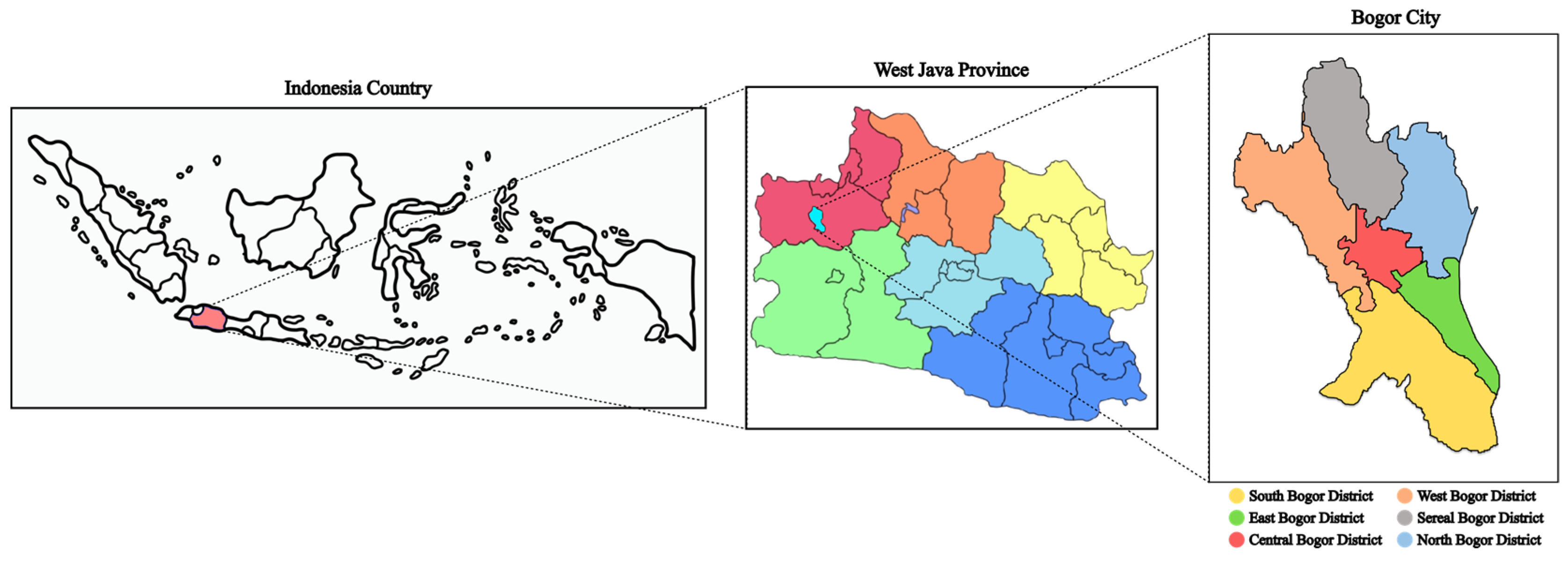
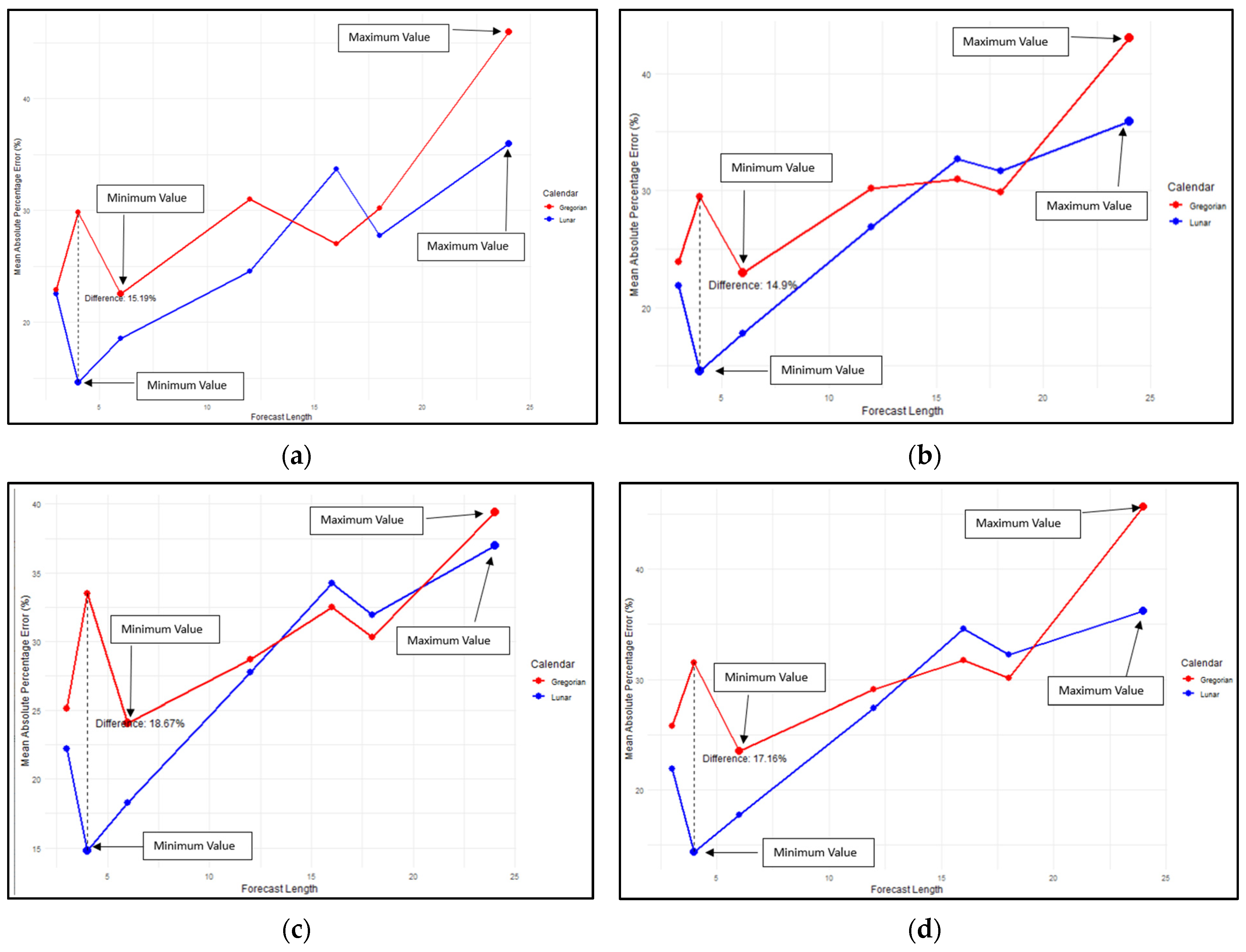

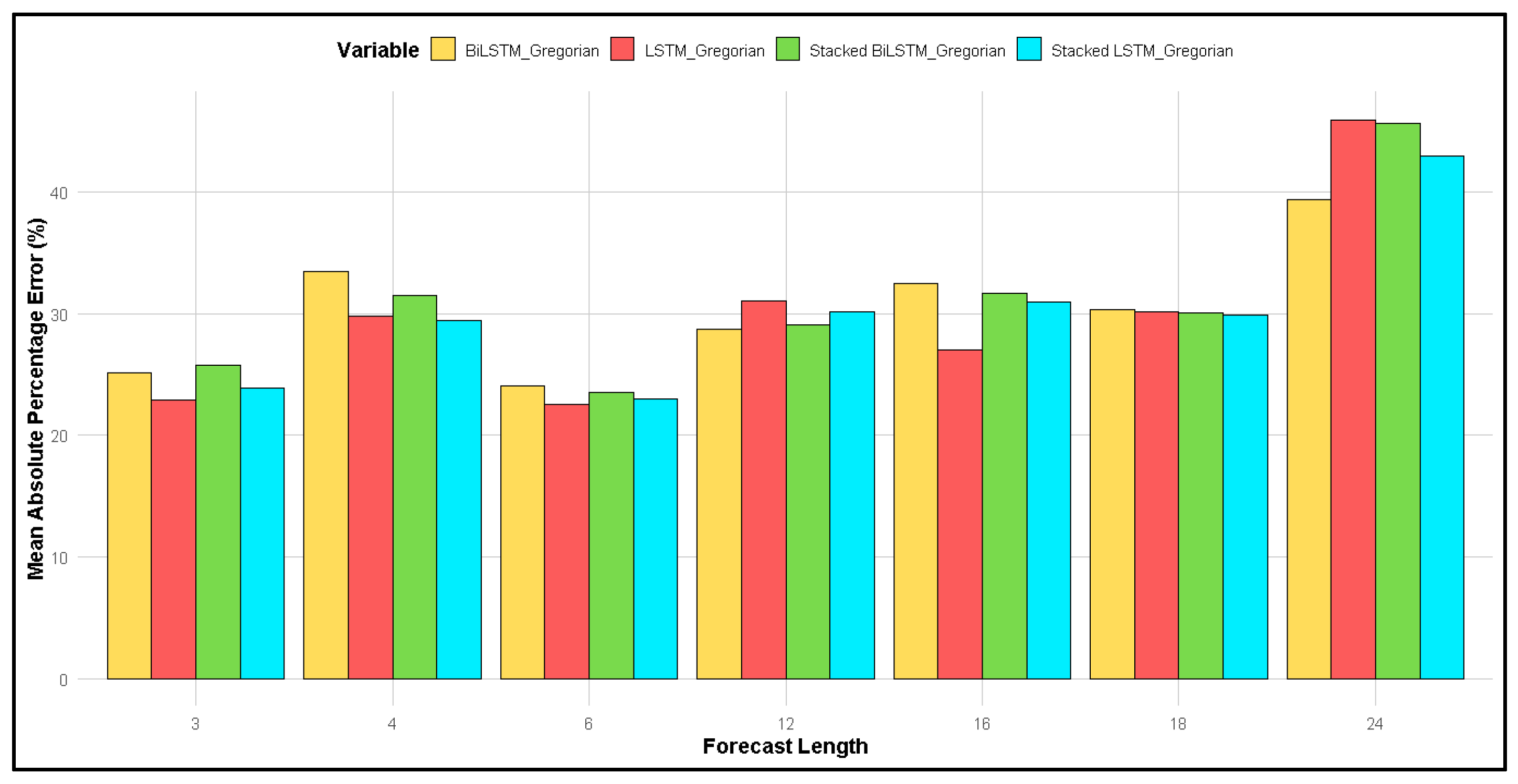
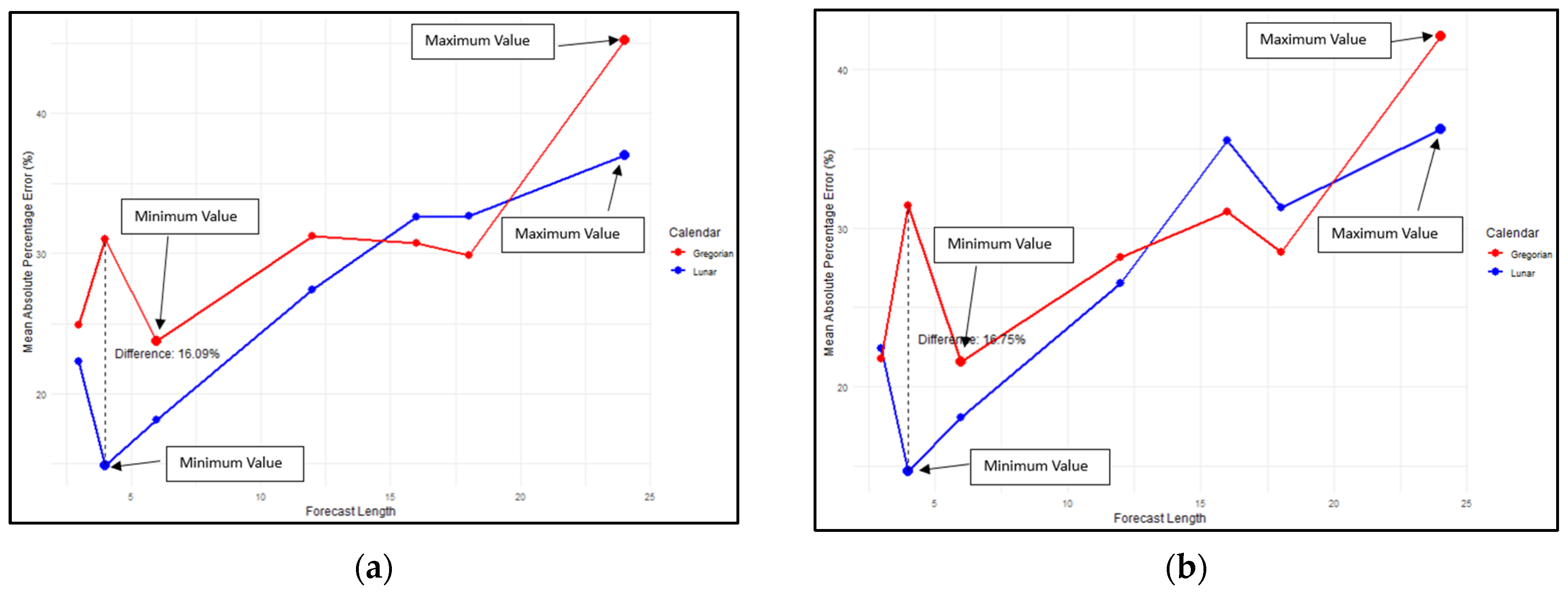

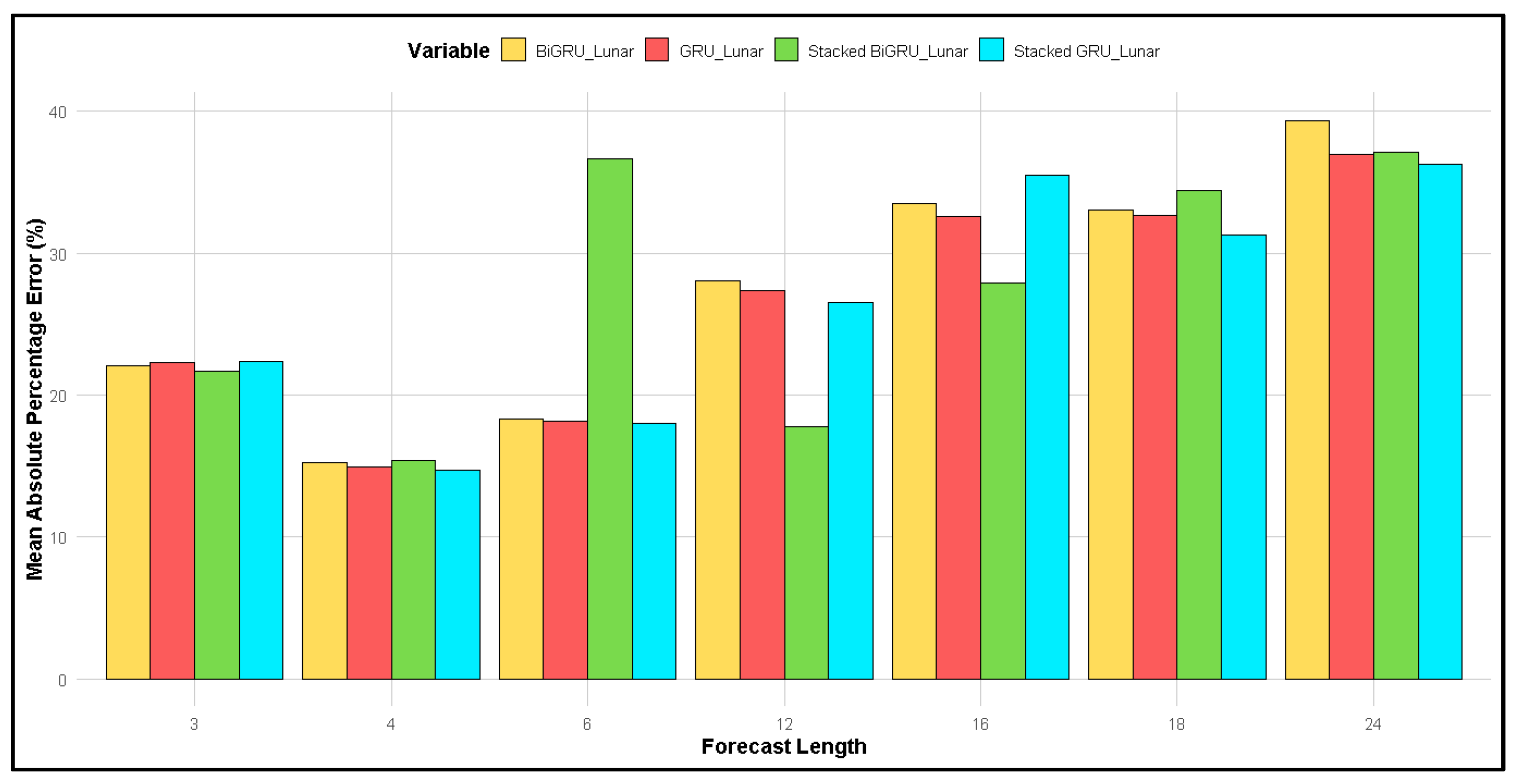
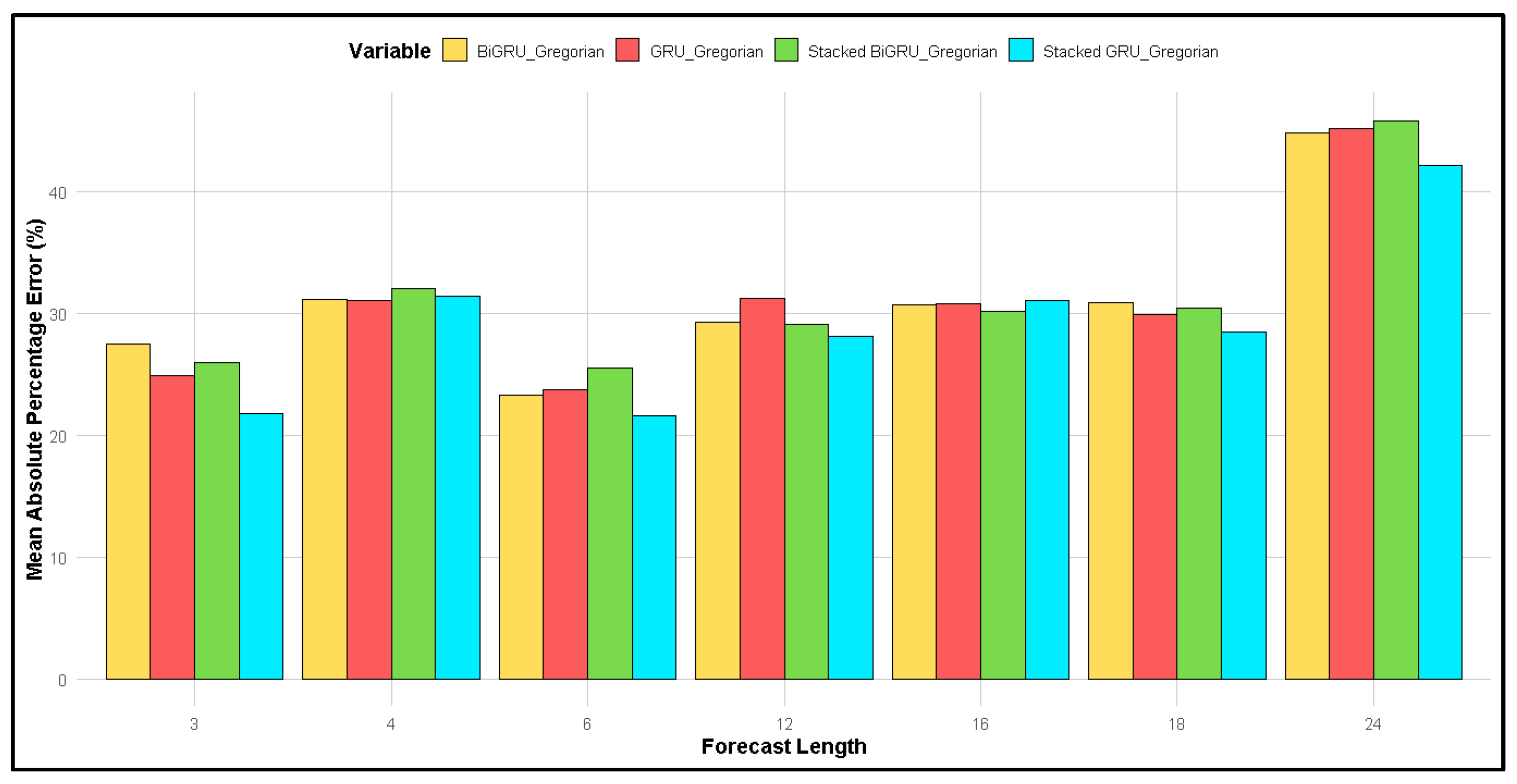
| Month-Year Gregorian | Monthly Rainfall (mmHg) | Month-Year Lunar | Monthly Rainfall (mmHg) |
|---|---|---|---|
| April 2000 | 449 | Dhul Hijri 1420 | 84 |
| May 2000 | 339 | Muharram 1420 | 493 |
| Jun 2000 | 295 | Safar 1420 | 263 |
| Jully 2000 | 376 | Rabi Ul-Awal 1420 | 348 |
| September 2022 | 250.7 | Safar 1444 | 444.7 |
| October 2022 | 505.3 | Rabi Ul-Awal 1444 | 334.1 |
| November 2022 | 299.2 | Rabi Al-Akbar 1444 | 303.4 |
| December 2022 | 428.7 | Jumadil Awal 1444 | 198.6 |
| Calendar | Forecast Length | Methods | |||||||
|---|---|---|---|---|---|---|---|---|---|
| LSTM | 2-Stacked LSTM | BiLSTM | 2-Stacked BiLSTM | GRU | 2-Stacked GRU | BiGRU | 2-Stacked BiGRU | ||
| Lunar | 3 | −37.06 | −29.76 | −21.18 | −27.96 | −19.46 | −18.52 | −19.56 | −17.53 |
| 4 | −34.47 | −27.94 | −18.92 | −26.14 | −17.35 | −16.94 | −18.02 | −16.04 | |
| 6 | −39.53 | −31.27 | −22.08 | −30.58 | −21.99 | −21.77 | −22.21 | −20.90 | |
| 12 | −36.22 | −30.85 | −23.63 | −30.22 | −22.17 | −21.90 | −21.79 | −20.91 | |
| 16 | −38.34 | −32.02 | −24.31 | −31.09 | −23.72 | −23.28 | −22.77 | −21.79 | |
| 18 | −37.98 | −31.70 | −23.77 | −30.74 | −23.35 | −22.95 | −22.53 | −21.50 | |
| 24 | −37.56 | −31.29 | −23.52 | −30.61 | −23.25 | −22.78 | −22.41 | −21.33 | |
| Gregorian | 3 | −201.38 | −159.13 | −176.36 | −162.96 | −160.44 | −137.57 | −140.85 | −134.68 |
| 4 | −153.72 | −129.93 | −136.88 | −130.91 | −130.55 | −108.12 | −110.22 | −106.02 | |
| 6 | −102.81 | −88.36 | −91.73 | −88.56 | −88.23 | −73.62 | −74.53 | −72.79 | |
| 12 | −62.44 | −58.34 | −61.98 | −59.55 | −58.26 | −50.77 | −51.96 | −50.42 | |
| 16 | −48.47 | −46.78 | −50.82 | −47.70 | −46.62 | −40.62 | −41.39 | −40.23 | |
| 18 | −43.85 | −41.45 | −45.06 | −42.51 | −41.17 | −35.81 | −36.10 | −35.26 | |
| 24 | −30.97 | −29.60 | −33.20 | −30.90 | −29.24 | −26.24 | −27.29 | −26.07 | |
| Calendar | Evaluation | Methods | |||||||
|---|---|---|---|---|---|---|---|---|---|
| LSTM | 2-Stacked LSTM | BiLSTM | 2-Stacked BiLSTM | GRU | 2-Stacked GRU | BiGRU | 2-Stacked BiGRU | ||
| Lunar | MAPE (%) | 13.94 | 13.94 | 9.08 | 14.56 | 14.16 | 14.74 | 14.96 | 15.00 |
| MBE | 3.60 | −10.87 | −18.10 | −17.07 | −18.57 | −18.05 | −3.18 | −3.29 | |
| Gregorian | MAPE (%) | 16.33 | 18.09 | 15.70 | 16.54 | 16.84 | 16.68 | 17.55 | 18.52 |
| MBE | −15.92 | −12.77 | −20.58 | −21.58 | −20.08 | −19.03 | −3.41 | −3.41 | |
Disclaimer/Publisher’s Note: The statements, opinions and data contained in all publications are solely those of the individual author(s) and contributor(s) and not of MDPI and/or the editor(s). MDPI and/or the editor(s) disclaim responsibility for any injury to people or property resulting from any ideas, methods, instructions or products referred to in the content. |
© 2025 by the authors. Licensee MDPI, Basel, Switzerland. This article is an open access article distributed under the terms and conditions of the Creative Commons Attribution (CC BY) license (https://creativecommons.org/licenses/by/4.0/).
Share and Cite
Darmawan, G.; Setyanto, G.R.; Faidah, D.Y.; Handoko, B. Lunar Calendar Usage to Improve Forecasting Accuracy Rainfall via Machine Learning Methods. Appl. Sci. 2025, 15, 675. https://doi.org/10.3390/app15020675
Darmawan G, Setyanto GR, Faidah DY, Handoko B. Lunar Calendar Usage to Improve Forecasting Accuracy Rainfall via Machine Learning Methods. Applied Sciences. 2025; 15(2):675. https://doi.org/10.3390/app15020675
Chicago/Turabian StyleDarmawan, Gumgum, Gatot Riwi Setyanto, Defi Yusti Faidah, and Budhi Handoko. 2025. "Lunar Calendar Usage to Improve Forecasting Accuracy Rainfall via Machine Learning Methods" Applied Sciences 15, no. 2: 675. https://doi.org/10.3390/app15020675
APA StyleDarmawan, G., Setyanto, G. R., Faidah, D. Y., & Handoko, B. (2025). Lunar Calendar Usage to Improve Forecasting Accuracy Rainfall via Machine Learning Methods. Applied Sciences, 15(2), 675. https://doi.org/10.3390/app15020675








